Related Research Articles

TamLin is a character in a legendary ballad originating from the Scottish Borders. It is also associated with a reel of the same name, also known as the Glasgow Reel. The story revolves around the rescue of Tam Lin by his true love from the Queen of the Fairies. The motif of winning a person by holding him through all forms of transformation is found throughout Europe in folktales.

"Snow White" is a German fairy tale, first written down in the early 19th century. The Brothers Grimm published it in 1812 in the first edition of their collection Grimms' Fairy Tales, numbered as Tale 53. The original German title was Sneewittchen; the modern spelling is Schneewittchen. The Grimms completed their final revision of the story in 1854, which can be found in the 1857 version of Grimms' Fairy Tales.

A changeling, also historically referred to as an auf or oaf, is a human-like creature found throughout much of European folklore. A changeling was a substitute left by a supernatural being when kidnapping a human being. Sometimes the changeling was a 'stock', more often the changeling was a supernatural being made magically to look like the kidnapped human.
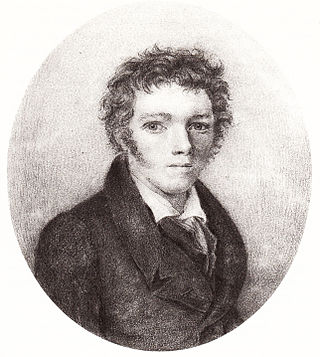
Wilhelm Hauff was a German poet and novelist.
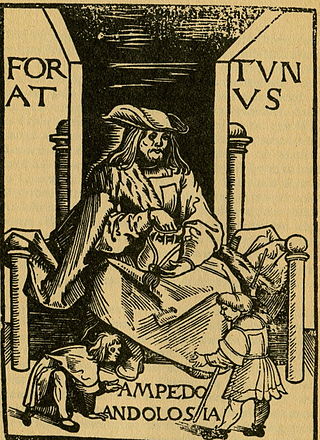
Fortunatus is a German proto-novel or chapbook about a legendary hero popular in 15th- and 16th-century Europe, and usually associated with a magical inexhaustible purse.
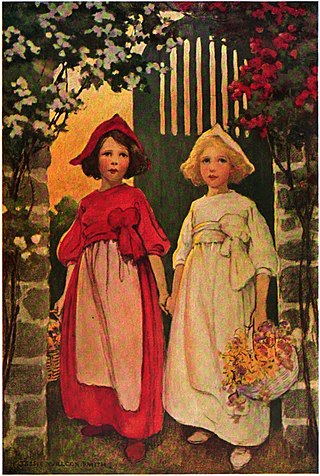
"Snow-White and Rose-Red" is a German fairy tale. The best-known version is the one collected by the Brothers Grimm in 1837 in the third edition of their collection Grimm's Fairy Tales. It was first published by Wilhelm Grimm in 1827 in Wilhelm Hauff's Märchen-Almanach. An older, somewhat shorter version, "The Ungrateful Dwarf", was written by Caroline Stahl (1776–1837). Indeed, that appears to be the oldest variant; no previous oral version is known, although several have been collected since its publication in 1818. Oral versions are very limited regionally. The tale is of Aarne-Thompson type 426.

"The Juniper Tree" is a German fairy tale published in Low German by the Brothers Grimm in Grimm's Fairy Tales in 1812. The story contains themes of child abuse, murder, cannibalism and biblical symbolism and is one of the Brothers Grimm's darker and more mature fairy tales.

"East of the Sun and West of the Moon" is a Norwegian fairy-tale. It was included by Andrew Lang in The Blue Fairy Book (1889).

"The Black Bull of Norroway" is a fairy tale from Scotland. A version titled "The Black Bull of Norroway" in the 1870 edition of Popular Rhymes of Scotland was reprinted in an Anglicised version by Joseph Jacobs in his 1894 book More English Fairy Tales.
"Cap-o'-Rushes" is an English fairy tale published by Joseph Jacobs in English Fairy Tales.

"Allerleirauh" is a fairy tale recorded by the Brothers Grimm. Since the second edition published in 1819, it has been recorded as Tale no. 65. Andrew Lang included it in The Green Fairy Book.
"The Earl of Mar's Daughter" is an English-language folk song.

"Donkey Cabbages" is a German fairy tale collected by the Brothers Grimm, tale number 122. A man shoots birds in a forest and gains magical objects. By also ingesting the heart of one of the birds he shot, he acquires an inexhaustible source of wealth. Later on, his magical abilities and items are stolen by a trio of witches, but he regains everything thanks to a magical herb that causes one to transform into a donkey.

The Yellow Dwarf is a French literary fairy tale by Madame d'Aulnoy. Andrew Lang included it in The Blue Fairy Book.

Bluebeard is a 1944 American historical film noir directed by Edgar G. Ulmer, starring John Carradine in the title role. The film also stars Jean Parker. The film is based on the famous French tale Barbe bleue that tells the story of a violent nobleman in the habit of murdering his wives and the attempts of one wife to avoid the fate of her predecessors. The film is registered in the public domain.
Molly Whuppie is an English language fairy tale set in Scotland. It was first published in 'Three Folk-Tales from Old Meldrum, Aberdeenshire' in "Folklore" (6.2.1884). Rev. Walter Gregor said that the tales had been 'communicated to me by Mr. Moir, Rector of the Grammar School, Aberdeen. He had them from his mother, who kindly wrote out " Mally Whuppie " and " The Red Calf" at my request.' Anglicising the name to "Molly" from "Mally" Joseph Jacobs used this source of the story in his English Fairy Tales. A Highland version, Maol a Chliobain, was collected by John Francis Campbell in Popular Tales of the West Highlands. Jacobs noted the relationship between the two tales, and an Irish variant, "Smallhead," and concluded that the tale was Celtic in origin.
Fortunée or Felicia and the Pot of Pinks is a French literary fairy tale, written by Madame d'Aulnoy. Andrew Lang included it in The Blue Fairy Book.
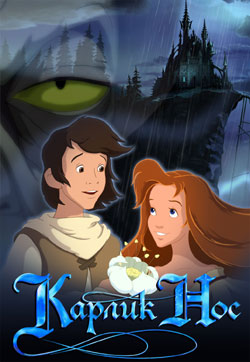
Little Longnose is a Russian traditionally animated feature film directed by Ilya Maximov. It was co-produced by Melnitsa Animation Studio and CTB, and is the first feature-length animated film by either company. The film is a combined adaptation of the fairy tales "Dwarf Nose" and "Little Muck" by Wilhelm Hauff.

Die ProSieben Märchenstunde is a television movie series that has been produced since 2006. It features characters that are exclusively portrayed by German and Austrian comedians and actors. The series is shot in Prague.
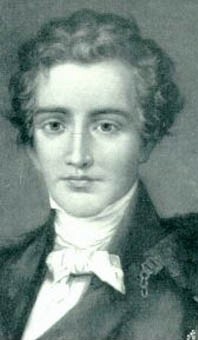
The story of Little Muck is a fairy tale written by Wilhelm Hauff. It was published in 1826 in a collection of fairy tales and tells the story of an outsider called Little Muck.
References
- ↑ Wührl, Paul-Wolfgang (2012). Das deutsche Kunstmärchen: Geschichte, Botschaft und Erzählstrukturen. Hohengehren: Schneider Verlag. p. 196.